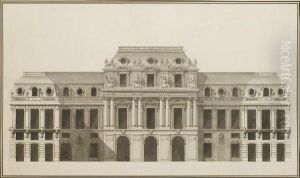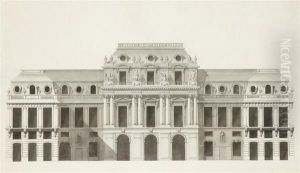Pierre Contant, Dit Constant D'Ivry Paintings
Pierre Contant d'Ivry, also known as Constant d'Ivry, was a French architect and designer, born on the 11th of October, 1698 in Ivry-sur-Seine, France. He is known for his work in the Rococo style, as well as for his contributions to Neoclassicism. Constant d'Ivry began his career as an artist under the tutelage of Germain Boffrand, a prominent architect of the late Baroque period. He later went on to study in Rome, which was a customary practice for French artists of the time, to enhance their education and exposure to classical antiquity.
During his stay in Italy, Constant d'Ivry was influenced by the Baroque architecture and the early signs of Neoclassical sentiments emerging in Europe. Upon his return to France, he brought with him the Italian Baroque style, which he merged with the French Rococo. He became one of the early adopters of the Neoclassical style in French architecture. Among his notable works is the church of Saint-Eustache in Paris, where he was involved in the design of the facade, although it was later completed by another architect, Jean Hardouin-Mansart.
Constant d'Ivry's works included religious buildings, private residences, and interior designs. He also worked on the Palais-Royal and the Hôtel d'Évreux, which is now the Élysée Palace, the residence of the President of France. In the realm of decorative arts, he designed furniture and other interior decorations that exemplified the Rococo style's intricate and ornate characteristics.
Pierre Contant d'Ivry's influence extended beyond his own projects. He was a member of the Académie Royale d'Architecture, and through his position, he was able to influence the direction of French architecture during his time. His legacy was also carried on by his pupils, who continued to propagate his architectural ideas and style. He passed away on the 1st of October, 1777 in Paris. His body of work remains an important part of the French architectural heritage, capturing the transition from the flamboyant Rococo to the more restrained and classical Neoclassicism.

